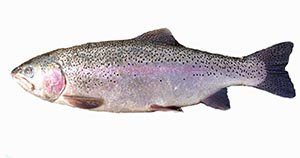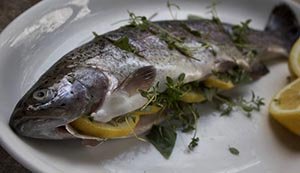Trout fish Nutrition facts
Trout is a highly prized freshwater fish with very fine, aromatic flesh. Trouts generally prefer cold waters of lakes and rivers, although some trout species live in the sea; in this case, they return to freshwater to spawn, like salmon.
Scientifically, trout belongs to the Salmonidae family and are closely related to salmon, char and grayling.
 |
| Rainbow trout. |
Several species of trout make Northern Hemisphere Rivers and oceans their home. Their flesh is semi-fatty, very fine, and aromatic. Trout's delicate flavor varies slightly depending on the species. Their meat also varies in color, being white, ivory, pink, and reddish depending upon varying feeding characteristics.
Brown trout or European trout has pink flesh which is delicious. The rainbow trout owes its name to the horizontal band of color, varying from dark pink to bright red that features on its metal-blue backsides.
Lake char or American char is distinguished from the others by its more elongated body, usually spotted with pale, sometimes yellowish, markings, and by its forked tail. It varies in color.
Brook trout or speckled trout is smaller.
Arctic char is distinguished by the beauty of its colorings, often dark blue or blue-green on the back, silver-blue on the sides, and white on its belly. Its sides are flecked with large red, pink, or cream spots. Its size varies depending on its habitat.
Grayling has a scent of thyme when freshly caught. Its whole body is flecked with a variable number of lozenge-or-V-shaped markings. It is a very beautiful fish that can measure 16-20 in. (40-50 cm) in length.
Description:
Trout are oily fish and exhibit similar external features as salmon; are large, elongated, oval bodies, small heads, small eyes, and a lower opening mouth that open back below its eye. The body features a dorsal fin dotted with large iridescent red or purple spots. Generally dark on the back and has iridescent gray sides with large scales and a total of seven fins. Adult freshwater rainbow trout grows 1-2 feet long and weighs up to 5-7 pounds, while migrating steelheads (anadromous forms) may reach 20 lb (9 kg).
Life cycle:
Irrespective of whether fresh or saline-water habitat, trouts return to their natal waters for reproduction. Tiny alevins and small fry need cold, clean, oxygenated water to survive and feed primarily on plankton, insect larvae, and other fish larvae.
Some coastal rainbow trout (steelhead) are anadromous which live in ocean water as adults but migrate into freshwater to spawn. Trout fish lifespan varies widely from 7 years for rainbow trout to 15-20 years for Lake trout (Salvelinus namaycush).
Habitat:
Trout is symbolic of the clear, cold streams of the northern wilderness. Some species spend their entire life in freshwater cold streams, rivulets, and small rivers. Anadromous trout species are migratory, completing their journey from natal freshwater streams, rivers, lakes, cold creeks, estuaries open bays, and deep ocean waters and back again to its natal waters to spawn.
Health Benefits of Trout Fish
Being a semi-fatty fish, trout is low in calories; 100 g fish hold just 149 cal in contrast to 160 cal of salmon.
Trouts boast a good amount of protein. Their lean meat composes 20.77 g/100 g (37% of RDI) of protein, being complete in all essential amino acids in healthy proportions.
Studies suggest that consumption of seafood decreases the risk of heart attack, stroke, obesity, and hypertension. Seafood is low in saturated fat and higher in “heart healthful” polyunsaturated fat, including omega-3 fatty acids.
American Heart Association recommends consumption of at least 2 servings of oily fish to fulfill requirements of essential fatty acids, protein, minerals, and fat-soluble vitamins.
All species of trouts are rich sources of vitamin A, vitamin D, and long-chain omega-3 fatty acids (PUFA).
As in other oily-fish types, trout also is a rich source of omega-3 eicosapentaenoicacid (EPA), docosapantaenoicacid (DPA) and docosahexaenoic acid (DHA) fatty acids. Research studies suggest that these fatty acids, particularly DHA, play an important role in the development of neural systems, especially in infants and children.
According to Cornell University and the New York Sea Grant Extension Program. 2012- These fatty acids can help lower blood pressure and heart rate and improve cardiovascular function. For example, research has shown that omega-3 fatty acids decrease the risk of arrhythmias (abnormal heartbeats) that can lead to sudden death. Omega-3 fatty acids also decrease triglyceride levels and slow the growth rate of atherosclerotic plaque.
In adults, several large trials have evaluated the effect of fish or fish oils on heart disease. In the "GISSI Prevention Trial, heart attack survivors who took a 1-gram capsule of omega-3 fats every day for three years were less likely to have a repeat heart attack, stroke, or die of sudden death than those who took a placebo".
The essential vitamins trout contains include niacin, vitamin B6, vitamin E, vitamin B12, thiamin, and riboflavin. In addition, being an oily fish, trout has generous amounts of vitamins A and D.
Trout has small amounts of Vitamin-A (57 IU/100g) on comparison to salmons. vitamin-A and omega-3 are essential for healthy mucosa and skin.
Trout flesh contains less vitamin D (155 IU/100g) than salmons (526 IU/100 g). Vitamin D plays an important role in the calcium metabolism and offers protection from cancers.
The Food and Drug Administration (FDA) recommends that pregnant women eat at least 8 ounces and up to 12 ounces (340 grams) of a variety of seafood lower in mercury a week.
Trouts are naturally rich sources of minerals including calcium, zinc, potassium, phosphorus, and magnesium. It is also a rich dietary source of iodine.
| Principle | Nutrient Value | Percent of RDA |
|---|---|---|
| Energy | 148 Kcal | 7.4% |
| Carbohydrates | 0 g | 0% |
| Protein | 20.77 g | 37% |
| Total Fat | 6.61 g | 33.5% |
| Cholesterol | 0 mg | 0% |
| Dietary Fiber | 0 g | 0% |
| Vitamins | ||
| Folates | 13 μg | 3% |
| Niacin | 4.500 mg | 28% |
| Pyridoxine | 0.200 mg | 15% |
| Riboflavin | 0.330 mg | 25% |
| Thiamin | 0.350 mg | 29% |
| Vitamin-A | 57 IU | 2% |
| Vitamin-C | 0.5 mg | 1% |
| Vitamin-D | 155 IU | 39% |
| Vitamin-E | 0.20 mg | 1% | Electrolytes |
| Sodium | 52 mg | 3.5% |
| Potassium | 361 mg | 7.6% |
| Minerals | ||
| Calcium | 43 mg | 4.3% |
| Iron | 1.50 mg | 19% |
| Magnesium | 22 mg | 5.5% |
| Phosphorus | 245 mg | 35% |
| Zinc | 0.66 mg | 6% |
| Omega-3 fatty acids (PUFA) | ||
| EPA (20:5 n-3) | 0.202 g | -- |
| DPA (22:5 n-3) | 0.183 g | -- |
| DHA (22:6 n-3) | 0.528 g | -- |
Buying
You can buy trout fresh or frozen, whole, trimmed, fileted, and sometimes steaks. It is also available smoked, salt-cured, or in cans.
Buy good quality fish from authentic sellers. Buy a whole trout side or a fillet that is from the thickest cut of the fish. Wild-caught trout will have pinker and brighter flesh than farmed ones. Wild fish are nutritionally rich and contain fewer toxins than farmed ones. There are some reported cases of artificial colorants/dye in farmed trouts to portray them as pink, wild trout.
In the markets, you can find products similar to salmon- ready-to-cook pâté, kabobs, and marinated and peppered trout steaks and fillets, salted trout, and burgers.
Like in salmons, avoid trout fish with a strong amine odor. Avoid smoked trout with leaky and wet edges.
Trout spoils quickly as its flesh is fatty and attracts bacteria. Always store fillets/sections of fish in a deep freezer.
Preparation
Prepare trout as simply as possible so as not to mask its delicate flavor. Smoked trout is delicious. All recipes for salmon are suitable for trout.
The scales on the skin can be left on. The fillets are very easy to remove. The flesh close to the head of the trout is more delicate than the flesh nearer the tail. If you prefer to skin, just peel it inside out. Remove any bones before cooking.
All recipes for salmon are suitable for trout. Trout may be pan-roasted, shallow fried, broiled, foil-baked, and grilled in the preparation of a variety of mouth-watering menus. Just ensure it should be cooked until the meat is opaque and flakes off easily.
Here are some serving ideas:
 |
| Baked trout. Photo credit: Jan Murin |
Like salmon, trout is used in the preparation of sandwiches, salads, omelets, pasta dishes, mousses, and quiches.
Smoked trout is served with capers and cream cheese as an appetizer.
Marinade whole trout with lemon slices and herbs (minced garlic, thyme, parsley, peppercorns, etc) for an hour. Then bake or grill and serve with lemon wedges.
Canned trout is used to make mousse, soufflés, pâté and crepes. As a spread, it is used on sandwiches, and canapés.
In Japan ikura is a red caviar made from the roe of salmon, trout, or cod. It is employed in sushi, and rice dishes in Japan.
Safety profile
Farmed trout may contain polychlorinated biphenyls (PCBs) and antibiotics which can have harmful effects on health. Also, there are confirmed reports that artificial dyes are injected into fish flesh to make them appear pink.
Trout, being seafood, may harbor microorganisms, such as parasites, bacteria, and viruses, that may cause foodborne illness. It is important to handle seafood safely to prevent foodborne illness. (Medical disclaimer).
≺≺ You may also like to read -Brook trout.
≺≺ Also- Salmon nutrition facts and health benefits.
≺≺ Back to Seafood from Trout fish nutrition facts and health benefits.
Further reading (Links opens in new window):
Rainbow trout. PDF.
Omega-3 Fatty Acids: An Essential Contribution.